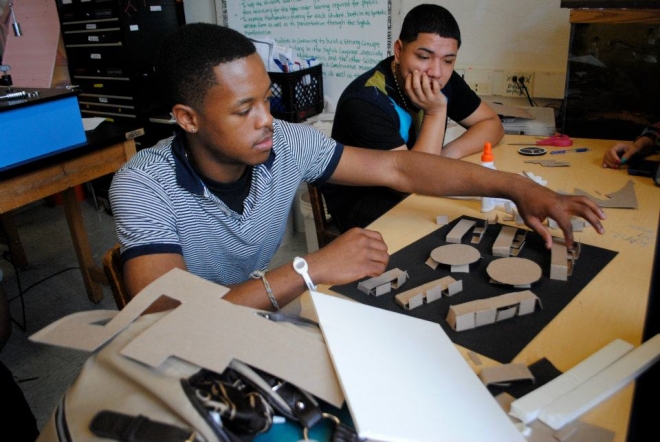Three Boston organizations - LBD, Urban Neighborhood Design Alliance, and YouthBuild Boston’s Designery - have begun an informal partnership. All three organizations serve K-12 students but with slightly different focus. Each organization compliments one another, and before collaboration were competing for resources - such as donations, volunteers, and media space.
The Collaborative has been meeting for the past few months and has begun to partner on programs. Recently, they worked together to bring 20 teens and 20 professionals together to engage in an afternoon design challenge. AAO catches up with the Collaborative to discuss the merits of this type of partnership and how this can be duplicated in other communities.
AAO: It sounds like each of the organizations in the Collaborative is interested in keeping its own identity, audience, and program. So what’s an example of a type of activity or opportunity where you see the collaboration as particularly useful?
Collaborative (C): Programmatically we compliment one another. UNDA works with high-school kids during school time, the Designery offers programs to high school kids after school and during the summer, and LBD focuses on K-8 students and professional development for teachers. But we had realized that in terms of fundraising and outreach, we target the same demographic – professionals in the architecture and construction field. We initially came together with the thought of creating a fund that that would establish support for K-12 design ed in Boston. As we met over the past six months we realized that our shared goals could be realized only with an expansion of what the collaborative could be.
Our collaborative goal is for every Boston student to have one quality design education experience in their K-12 school life. Through sharing resources we hope will help us achieve our collective goal of reaching more students.
Our collaborative offers a comprehensive program that is easy for our supporters to become involved with while offering a myriad of opportunity to youth, some of which may take more than one program from three different organizations during their educational experience. Types of activities or opportunities may include design charrettes, neighborhood tours, visits to firms, or even someday internships.
AAO: Certainly you were aware of one another’s education programs prior to creating the Collaborative, but how frequently did you chat with one another? Was one of the draws of this partnership the chance to maintain more regular communications with one another?
Collaborative: We have had informal relationships in the past, recommending students and volunteers, even teaching together, so we knew each other well. Meeting regularly has had the outcome of pulling from various areas of expertise within our groups to host collaborative events where we are able to more effectively reach students, teachers, and professionals with a larger impact using less resources.
AAO: Is there an idea or lesson you’ve already taken from colleagues as a result of this partnership?
Learning by Design (LBD): For us these conversations have expanded how we talk about ourselves and think about our programs. We have thought more about how we can play a role in the ‘work force development’ conversation which our partners focus on already.
Urban Neighborhood Design Alliance (UNDA): We have realized the potential of a network rather than seeing the Designery and LBD:MA as competitors. UNDA has a hands-on learning approach that puts design professionals besides the students in a classroom and takes the students out to building job sites. We are now able to refer students that have become interested in design and construction to the Designery programs so that they can develop their newly discovered interests. LBD:MA introduces these ideas to children and plants the seed of design thinking early, which can be tremendously beneficial for youth that may participate in UNDA programming. We all have a real synergy that is beneficial to each organization.
Youth Build Boston has been able to more efficiently reach our goal of developing closer relationships with representatives within the Boston Public School system by sharing contacts. Through this effort YBB is able to recruit the best possible students for our program.
AAO: The needs of each local community might differ, but are there any suggestion you have for our readers who might be interested in testing this idea of a design ed collective in their own hometowns?
Collaborative:
- Hold an open meeting amongst like minded organizations and start talking about the programs being offered. Chances are that organizations will find opportunities for collaboration rather than competition.
- Talk about what the foundations and funders are looking for from organizations. How can you develop better programs with greater reach? Will funding agencies support a grant application from a group of NPO's that are collaborating?
- Start out with a small collaborative event or presentation. Planning these types of events will usually put all of the issues on the table. All organizations should share equal responsibility, and the best case scenario finds organizations stepping in where their specific strengths are.
- Talk to the design community to find out if they can distinguish between the different organizations providing similar programs. Chances are they can't and that they would love one "go-to" organization that can make a big impact.
AAO: What are planning to do together at the ABX event next month?
Collaborative: This is our next collaborative event (of many!). ABX is the annual Building and construction industries trade show. Hundreds of workshops are offered for architects on a variety of topics. Our three organizations will be hosting a panel discussion around young people and the future of design profession. Participants will learn how our organizations continue to shape youth design education in our communities and how the design and construction industries can successfully Participants will learn how our organizations continue to shape youth design education in our communities and how the design and construction industries can successfully make an impact.

